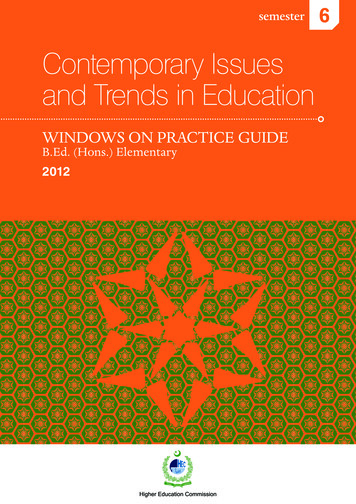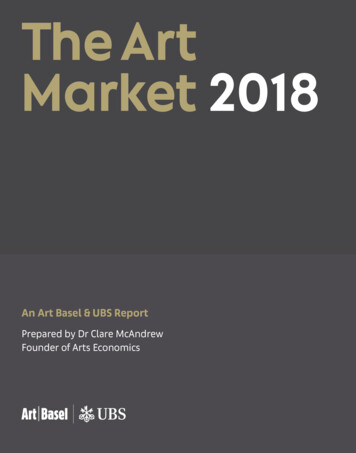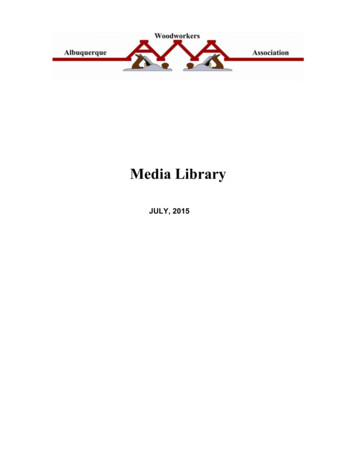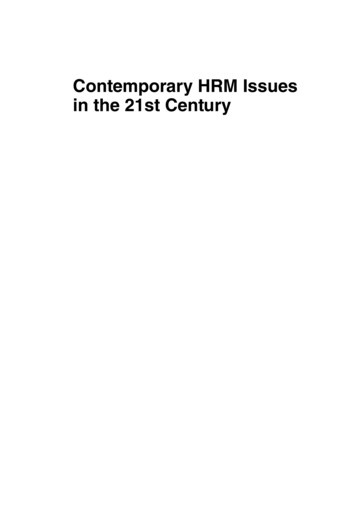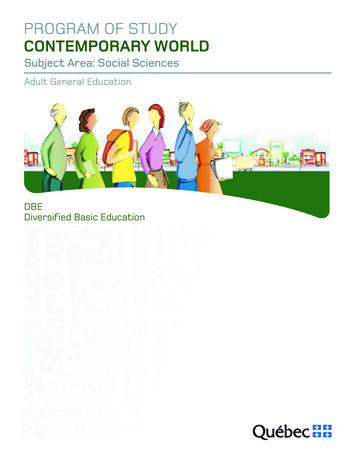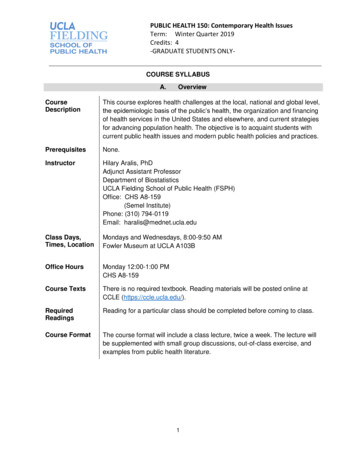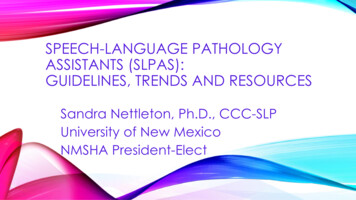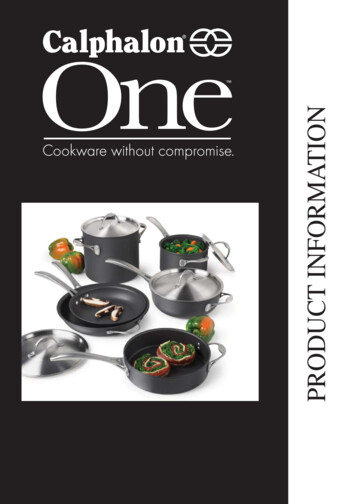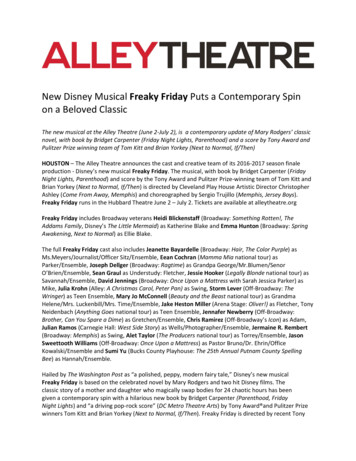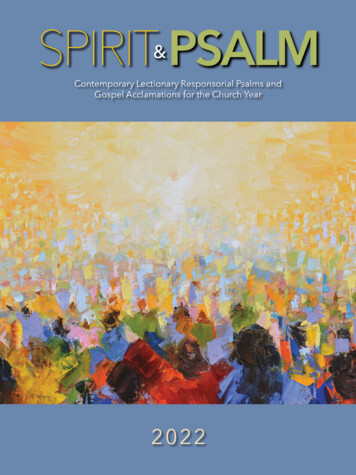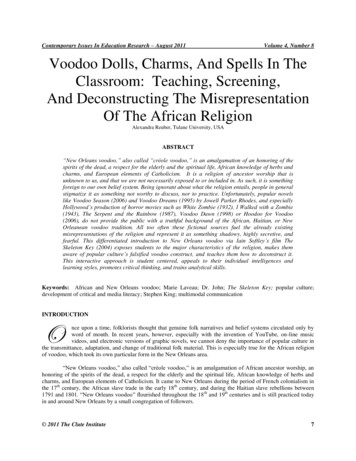
Transcription
Contemporary Issues In Education Research – August 2011Volume 4, Number 8Voodoo Dolls, Charms, And Spells In TheClassroom: Teaching, Screening,And Deconstructing The MisrepresentationOf The African ReligionAlexandra Reuber, Tulane University, USAABSTRACT“New Orleans voodoo,” also called “créole voodoo,” is an amalgamation of an honoring of thespirits of the dead, a respect for the elderly and the spiritual life, African knowledge of herbs andcharms, and European elements of Catholicism. It is a religion of ancestor worship that isunknown to us, and that we are not necessarily exposed to or included in. As such, it is somethingforeign to our own belief system. Being ignorant about what the religion entails, people in generalstigmatize it as something not worthy to discuss, nor to practice. Unfortunately, popular novelslike Voodoo Season (2006) and Voodoo Dreams (1995) by Jowell Parker Rhodes, and especiallyHollywood’s production of horror movies such as White Zombie (1932), I Walked with a Zombie(1943), The Serpent and the Rainbow (1987), Voodoo Dawn (1998) or Hoodoo for Voodoo(2006), do not provide the public with a truthful background of the African, Haitian, or NewOrleanean voodoo tradition. All too often these fictional sources fuel the already existingmisrepresentations of the religion and represent it as something shadowy, highly secretive, andfearful. This differentiated introduction to New Orleans voodoo via Iain Softley’s film TheSkeleton Key (2004) exposes students to the major characteristics of the religion, makes themaware of popular culture’s falsified voodoo construct, and teaches them how to deconstruct it.This interactive approach is student centered, appeals to their individual intelligences andlearning styles, promotes critical thinking, and trains analytical skills.Keywords: African and New Orleans voodoo; Marie Laveau; Dr. John; The Skeleton Key; popular culture;development of critical and media literacy; Stephen King; multimodal communicationINTRODUCTIONOnce upon a time, folklorists thought that genuine folk narratives and belief systems circulated only byword of mouth. In recent years, however, especially with the invention of YouTube, on-line musicvideos, and electronic versions of graphic novels, we cannot deny the importance of popular culture inthe transmittance, adaptation, and change of traditional folk material. This is especially true for the African religionof voodoo, which took its own particular form in the New Orleans area.“New Orleans voodoo,” also called “créole voodoo,” is an amalgamation of African ancestor worship, anhonoring of the spirits of the dead, a respect for the elderly and the spiritual life, African knowledge of herbs andcharms, and European elements of Catholicism. It came to New Orleans during the period of French colonialism inthe 17th century, the African slave trade in the early 18 th century, and during the Haitian slave rebellions between1791 and 1801. “New Orleans voodoo” flourished throughout the 18 th and 19th centuries and is still practiced todayin and around New Orleans by a small congregation of followers. 2011 The Clute Institute7
Contemporary Issues In Education Research – August 2011Volume 4, Number 8Nevertheless, all too often voodoo has been given a negative connotation and has been compared to devilworship, witchcraft, hexing, and conjure. Needless to say, that teaching about voodoo through its representation inpopular culture often leads to misunderstandings. In the past, colleagues expressed their surprise and disbelief abouttopic choice and educational resource in questions, such as “Do you really believe in this hocus-pocus?” or “Really,you teach a segment on voodoo through popular culture?” But why do colleagues utter these questions of disbelief?Does this topic not fulfill the high academic standards we hold at our institutions? Or do colleagues react this way,because popular culture has painted too dark of a picture of voodoo?Students in my most recent folklore course on “The Haunting of Louisiana” gave the following answers tothe question, “What do you associate with voodoo?”: “witchcraft,” “some spiritual belief,” “power to cross anduncross someone,” “group religion,” “fear,” “ghosts,” “charms and spells,” and “voodoo dolls into which you stickneedles in order to harm someone.” These questions and terms suggest others, namely: Where does their“knowledge” come from? Why do they associate something evil and harmful with the term?The answer is simple. Voodoo, more so in the past than in the present has “been extremely secretive”(Tallant, 1984, p. 16) and exclusive. Moreover, it is a religion of ancestor worship that is unknown to us, and that weare not necessarily exposed to or included in. As such, it is something foreign to our own belief system. Beingignorant about what the religion entails, people in general stigmatize it as something not worthy to discuss, nor topractice. It becomes associated with supernatural powers, witchcraft, spirit possession, devil worship, and accordingto Robert Tallant, even with animal and child sacrifice (see Tallant, 1984, p. 8).Moreover, images of evil looking voodoo dolls or smiling skulls on Google, popular novels like VoodooSeason (2006) and Voodoo Dreams (1995) by Jowell Parker Rhodes, and especially Hollywood‟s production ofhorror movies such as White Zombie (1932), I Walked with a Zombie (1943), The Serpent and the Rainbow (1987),Voodoo Dawn (1998) or Hoodoo for Voodoo (2006), fuel the already existing misperceptions of the religion. Neitherone of these sources of popular culture provides the viewer with a truthful background of the African, Haitian, orNew Orleanean voodoo tradition. However, all of these sources portray voodoo as something shadowy, highlysecretive, and fearful.Even though Iain Softley‟s movie The Skeleton Key (2004) follows the Hollywood tradition by falselyconnecting religion with supernatural terror and body switching, the film differs from its predecessors in the waythat, for the first time in Hollywood history, a film clearly articulates and illustrates characteristics that arerepresentative for voodoo in general, and for New Orleans voodoo in particular.This being said, I will illustrate how I used popular culture in general, and the film The Skeleton Key, inparticular when teaching a unit about voodoo in my folklore class, “The Haunting of Louisiana” in Spring 2011.This unit, consisting of three 75 minutes class periods, however, can be integrated into any folklore, religion, orAmerican Southern Literature course. By using popular culture as a teaching tool, I achieved five goals: 8First, via the use of the YouTube movie trailer of The Skeleton Key, I use a popular medium to makestudents aware of foreign cultural, religious, and folkloristic values that they otherwise might dismiss.Second, through the discussion of the movie trailer, students learn about the voodoo religion, its history,belief system, common rituals.Third, through the discussion of individual film scenes, popular graphic art, and a study of Dr. John‟s song“Marie Laveau” (2004) students learn about New Orleans unique brand of voodoo—Creole voodoo—andits connection with Catholicism.Fourth, students understand the difference between voodoo and hoodoo.Fifth, through a guided discussion of selected film scenes of The Skeleton Key, students gain culturalknowledge, develop their media literacy, and learn how to assess and to deconstruct Hollywood‟s createdand falsified voodoo construct. 2011 The Clute Institute
Contemporary Issues In Education Research – August 2011Volume 4, Number 8PART I: INTRODUCTION TO VOODOOIn order to give all students a voice at the beginning of this unit and to get a feeling for their preexistingknowledge about the topic, I started with 5 minutes of free writing addressing the question, “What do you associatewith voodoo?” This individualized approach of the topic allowed students to collect and organize their ideas andunderstanding of the term „voodoo.‟ In a following period of group brainstorming of the same question, studentscommunicated their ideas that are represented in the mind-map below. Chart 1 illustrates the manifold andcontradictory description of what my students associated with the term „voodoo‟ at the beginning of this unit.Chart 1As soon as the students fell silent, I gave another impulse and showed the two-minute YouTube trailer(http://www.youtube.com/watch?v PiugxNeXj2Y) of the 2004 horror movie The Skeleton Key. By doing so, Iintroduced Hollywood‟s fear inspiring representation of the African religion and provided a nourishing ground forthe discussion of some important characteristics of the religion such as: the importance of candles, color symbolism,herbs, the calling of the spirits, the procedure of cleansing, sacrifice, and the use of voodoo dolls.This visual introduction to the topic was helpful in two ways. First, it allowed me to complete the initialword map and to make the students aware of the necessity of deconstructing Hollywood‟s falsified misconception ofthe voodoo religion. Second, the fast moving shots had a more appealing effect on the increasingly visual and mediaoriented student of the 21st century than a purely folkloric or religious introduction to or outline of the topic. Usingthe YouTube video facilitated setting the hook for this unit and helped to motivate students for a later academicstudy and discussion of the religion.After the screening, I collected new ideas from the class and completed the students‟ mind-map by addingadditional information and by connecting certain characteristics with each other (see Chart 2). Even though theresulting mind-map listed important characteristics of the voodoo religion, this illustration shows clearly that theclass was entrapped in Hollywood‟s voodoo construct that needed to be understood and dissolved. 2011 The Clute Institute9
Contemporary Issues In Education Research – August 2011Volume 4, Number 8Chart 2In the next step, I contrasted the students‟ mostly unrefined knowledge about voodoo with an excerpt takenfrom Carolyn Morrow Long‟s biography on A New Orelans Voudou Pristess. The Legend and Reality of MarieLaveau. This five page excerpt (pp. 93-97) provided students with a general overview of the religion‟s Africancultural heritage and its emergence in North America due to the slave trade. It introduced the reader to the religion‟ssupreme deity—the Bondyé—and to its spiritual entities called lwas, who can be defined as “representations ofheavenly bodies, stars, and planets” (Rigaud, 1985, p. 80) and who function “as intermediaries between humanbeings and the highest god” (Long, 2007, p. 94). After five minutes of silent reading, I chose individual referencesfrom the mind-map as well as passages from the text to outline and discuss the history and development of voodoo,its prominent beliefs, the function of some of its most important lwas, as well as its rituals of cleansing, (herbal)healing, dancing, and ancestor worship.Whereas the first half of the course addressed students‟ visual, auditory, and interpersonal intelligences, thesecond half focused more on their verbal and linguistic intelligence. To facilitate the learning process of the visuallearners who “prefer to read and visualize information” and for the sensory/sequential learners who “prefer toencounter new information by means of a step-by-step, ordered presentation” (Shrum, 2009, p. 353), I provided anoverview of the most important facts according to the following outline in Chart 3:Voodoo: An Introduction1. the history of voodoo,2. meaning of the term “voodoo” also spelled “vodou” or “vodu,”3. the religion‟s most important beliefs, animistic faith cult of ancestry worship belief in a supreme deity, the Bondyé, and its spiritual “helpers” lwas, e.g., Papa Legba, Danbhalah, Erzulie, Baron Samedi4. lwas and their representations: altars and vèvès,5. rituals, clensing dancing, drumming, and worshiping offering healing and prayingChart 310 2011 The Clute Institute
Contemporary Issues In Education Research – August 2011Volume 4, Number 8As a consequence, this second half of the lesson switched from a student-centered to a more teachercentered instruction, which was mainly characterized by a seminar style teacher-student interaction. I concluded thefirst lesson by discussing the following photos, which I had taken at a local voodoo ceremony in Fall 2009.Photo 1: Entrance To The Voodoo Temple Showing A Drawing Of The Vèvè Of Papa Legba, The Guarding Of TheCrossroads, As Well As Of Baron Samedi, The Lwa Of The DeadPhoto 2: An Altar Of The Ancestors Inside The Voodoo Temple Displaying Candles, Pictures, And Offerings 2011 The Clute Institute11
Contemporary Issues In Education Research – August 2011Volume 4, Number 8Photo 3: Voodoo Priestess Drawing Vèvès Of The CrossroadsCross Roads and Centre PostBasic symbol behind the idea of the Voudoun religion.Photo 4: Complete Vèvès Of The Crossroads And The Guédés, The Lwas Of The DeadVia the discussion of these photos, I was able to support and illustrate the preceding academic outline of thereligion‟s most important features, and correct the students‟ first impressions of the voodoo religion andHollywood‟s misrepresentation of the same in the YouTube trailer. Moreover, I was able to show the accuraterepresentation of the vèvès on the temple‟s ground. The introduction to these corn meal drawings representing theastral forces of the lwas was important for two reasons: First, these drawings play an important role in any voodooceremony. Only through the drawings of the vèvès, the lwas descend to earth (see Rigaud, 1985, p. 80). Second, inregard to the movie The Skeleton Key, it is imperative to discuss these ritual drawings and their connection to thelwas as Hollywood attaches a supernatural function of protection to them.I am, however, aware that not every teacher has this resource. Thus, I propose two options for how toconclude this first lesson on voodoo, depending on how engaged the particular group of students is. If the studentsare engaged in discussion and pose questions that further the ongoing dialogue about voodoo, I recommend to havethem learn by questioning, listening, responding, and evaluating each other‟s and the teacher‟s remarks. “As I statein my article “How to Use the Pop-Screen in Literary Studies,” discussions are a very valuable teaching tool as itforces the students to interact and to communicate their understanding of a topic, situation, or fact to others.” “It is12 2011 The Clute Institute
Contemporary Issues In Education Research – August 2011Volume 4, Number 8an activity that fosters the student‟s “independent thinking and self-confidence to present their opinions” (Reuber,2010, p. 27) to others and strengthens their interpersonal skills of communication.”If the group is less lively and engaged, the teacher might provide the students with additional authenticinput by showing a five minute documentary about the origins of voodoo produced by The History Channel. TheDVD‟s chapter “African Origins” (01:16-04:28) allows for the consolidation of the material presented, which thencan be accessed through controlled question-answer exercises. In both cases, the last five minutes of this first classperiod should be reserved for the discussion of the following two questions assessing the students‟ learning process:1)2)How can we complement, change, or correct our first impressions?How does the YouTube video trailer of “The Skeleton Key” represent the religion?As homework, students are asked to read chapter 3, “Voodoo,” in Kalila Smith‟s New Orleans Ghosts,Voodoo, and Vampires. Journey into Darkness and Troy Tayler‟s on-line article “Voodoo in New Orleans & TheLegacy of Marie Laveau.”PART II: NEW ORLEANS VOODOO HOODOOThe second 75 minutes class period focused on what priestess Anise Alvarado calls “New Orleans VoodooHoodoo” or “Creole Voodoo” (2009, p. 6). It concentrated on the unit‟s third and fourth objective: Students learningabout New Orleans unique brand of voodoo—Creole voodoo— its pairing “of African gods with Christian saints”(Thornton, 1988, p. 267), its inclusion of herbal healing, and of African magic.“A general discussion of Kalila Smith‟s and Troy Taylor‟s texts initiated my teacher-student exchangeabout the main characteristics of New Orleans‟s particular “brand” of voodoo: a religion that is loyal to its Africanand Haitian origins in honoring the ancestors, calling the lwas and making offerings to the spirits but at the sametime is innovative by blending these roots with European Catholicism and spiritualism as well as with “AfricanAmerican folk magic that operates independent of the gods” (Anderson, 2008, 42). According to Anderson “therecan be little doubt that hoodoo and voodoo were [actually] not separated before the late nineteenth century” (43),indicating that the two terms might have been used interchangeably, and that magic and spells were used as part ofboth, the African religion and the folk-magic.”This particular brand of New Orleans‟ voodoo is linked to the city‟s most popular and legendary voodooqueen, Marie Laveau, who, despite her attraction to and practice of voodoo, never abandoned her Catholic roots butrather combined voodoo lwas and catholic saints (see Smith, 2007, p. 122). Even though she was a very religiouswoman, according to Troy Taylor, Marie Laveau “was the source of hundreds of tales of terror and wonder in NewOrleans” (online). During the late 19th and early 20th centuries, her reputation and celebrated voodoo tradition “wereperceived as irresistibly scary and enticingly erotic” (Long, 2007, p. xxxi). As a free mulatto, whose ancestryremains unknown1, whose first husband Jacques Paris disappeared and presumably died “in one of the fatal yellowfever epidemics” (Long, 2007, p. 50), whose second husband, Christophe Glapion, gave her 13 children, MarieLaveau—mother, hairdresser, devoted catholic, and powerful voodoo queen—is of course subject to speculation.But does this sensational perception of a woman and of a religion justify the creation of popular culture‟s (and inparticular Hollywood‟s) all too often falsified voodoo construct in general and demonization of Marie Laveau inparticular?Popular culture takes great liberty in the representation of Marie Laveau as a “mythic and magical figure”(Long, 2007, xxxv). While disregarding her social engagement and later devotion to community and charitablework, popular novels, songs, and films always stress the influence and power Marie Laveau exercised over herfellow citizens. Since power means something positive for some and something negative, yet evil, for others, MarieLaveau soon became a woman with the most contradictory set of characteristics and values, much like New Orleansvoodoo itself.Spiritual power and insight sought through the communication with the ancestors and the different kind oflwas, often only achieved by undergoing great suffering and loss, has become tainted with derogative watchwords 2011 The Clute Institute13
Contemporary Issues In Education Research – August 2011Volume 4, Number 8such as witchcraft, hexing, and devil worship. These attitudes are graphically expressed in the pop-artrepresentations of Marie Laveau, showing her as a threatening dark power dancing with a snake and defining her as“the witch queen of New Orleans” (see Image 1).Image 1Since students nowadays are familiar with graphic art through their frequent exposure to comic books, aswell as video and computer games, these provocative images served as a great visual stimulus in class. Students notonly described the artistic representation of New Orleans‟ most famous voodoo queen with ease but also connectedthe artist‟s chosen symbolism to the characteristics of the voodoo religion. Chart 4 illustrates a combination of thedetermined symbols (on the left), students‟ interpretation of the symbols (in the middle), and my additional remarks(on the right).Depending on the interests and learning styles of the students, I suggest to complement this initialdiscussion of New Orleans‟ voodoo queen either by a partial screening of the documentary New Orleans VoodooQueen (30:20-36:32) produced by the History Channel or by playing the psychedelic rock song “Marie Laveau”(2004) composed by Malcolm John Rebennack, alias Dr. John, and its accompanying video(http://www.youtube.com/watch?v Lb8DlC3utYE) (00:06:45). Since I had several music lovers in my last courseon “The Haunting of Louisiana,” I chose the latter.In the following post-listening / post-viewing activity, students discussed first in pairs, then in a group, Dr.John‟s representation of Marie Laveau. By exchanging the ideas of how to understand Dr. John‟s presentation ofNew Orleans‟s voodoo queen, everybody was involved in the four classroom activities contributing to learning:listening/seeing, understanding, evaluating, presenting. More importantly, through the presentation of individualcomments, every student was “connecting to the material and lesson” (Yerigan, 2008, p. 19).Provoked by the lyrics and the video, students addressed the juxtaposition of Catholic faith and voodoo, theimportance of suffering and prayer, of offerings, of African root work, and the use of charms and spells for the NewOrleans‟ voodoo tradition. Students also stressed Marie Laveau‟s influence on and power over all members ofsociety: the poor, the rich, and even the legal representatives of the city.14 2011 The Clute Institute
Contemporary Issues In Education Research – August 2011Volume 4, Number 8Chart 4Symboldifferent skincolorsStudent commentreference to Marie Laveau‟s culturalbackground.red and white eyesreference to the good vs. bad side of voodooskull on herforehead and on herbraceletsnakereference to New Orleans voodoo hoodoo créole voodooreference to the Guédés, the lwas of the deadrepresentation of rebirthdance with the snake as a representation ofpowerTeacher RemarksLaveau was a free woman of color; daughter of the freeman of color Charles Laveau Trudeau and a black womanMarguerite.rada and petwo lwasWhereas rada lwas personify the healing aspects ofvoodoo, the often violent petwo lwas represent spell work.The lwas of the dead and the cemeteries find oftenrepresentation through a black cross, skull, shovel, andpickax. Baron Samedi is the main lwa of the dead.Li Grand Zombi, a large python snake that personifies theserpent god Danbhalah, als spelled Damballa, “a spirit thatspeaks through the snake” (Long, 2007, p. 116)He is among one of the most important lwa representingrebirth, connection between the realm of the living and thedead.The dance with the snake “symbolizes the unity betweenour world and the world beyond” (Smith, 2007, 116) and isstill a voodoo ritual in New Orleans.super-hero bras“Witch Queen”reference to her power and spiritual strengthreference to her magic power and propheticdreams,voodoo as witchcraft, hexing, and conjureblack and purpledressShe prepared and sold gris-gris bags. “Gris-gris, a generalterm for magic, came from the Mandingo tribe” (Anderson,2007, p. 28). Hence, the term is a cultural remain of theWest Africans who found their way to the United Statesduring the period of colonization and slave trade.Black and purple are the colors to honor the ancestors andthe guédés.Even though Dr. John‟s song and its accompanying video do not leave the listener or viewer with theimpression that Marie Laveau‟s magic was harmful, the sources‟ frequent allusion to her use of charms and gris-grismisled two of my former students to believe that she was practicing witchcraft. Here, it is important to differentiatebetween European witchcraft, African black magic, and root and spell work, of which the latter plays an importantrole in what Anise Alvarado defines as “New Orleans Voodoo Hoodoo” (2009, p. 6) -- a combination of religiousworship and of magic. Through discussion and clarification, all students in my class finally understood that NewOrleans voodoo should be perceived as a very particular form of voodoo, namely as a religion that is a “complexblend of multiple African religions and Christianity,” as well as of “African American folk magic that operatesindependent of the gods, communal ceremonies, and other religious trappings of Voodoo” (Anderson, 2008, p. 33;42). In this respect, Jeffrey E. Anderson might be right when calling Marie Laveau not only a voodoo queen, butalso a conjurer, a hoodoo doctor (see Anderson, 2007, p. 98). It is essential that students understand the notion ofNew Orleans voodoo hoodoo, prior to watching Iain Softley‟s film The Skeleton Key for the next class meeting.PART III: HOLLYWOOD’S VOODOO HOODOO – “THE SKELETON KEY”This last 75 minutes segment of the unit focused on the discussion of Iain Softley‟s film “The SkeletonKey” (2005) and on the understanding of Hollywood‟s created and falsified voodoo construct. It centered on thefollowing two questions: How is voodoo represented throughout the film?What constitutes Hollywood‟s voodoo construct in The Skeleton Key?The lesson started with a free-writing activity addressing the film‟s general representation of voodoo. Thequestion “How is voodoo represented throughout the film?” served as an initial impulse that gave each learner a 2011 The Clute Institute15
Contemporary Issues In Education Research – August 2011Volume 4, Number 8chance to organize his/her train of thought and to connect already learned material to the popular medium. Thisindividual “reading” of the film was then complemented by a ten minute presentation and open discussion of thestudent‟s associations, which forced them “to communicate their findings [expectations, and predictions] in a varietyof ways, to themselves and others” (Haworth, 2004, p. 69). 2Without hesitation, my students commented on for example the explicit differentiation between voodoo andhoodoo, conjure practices, rituals of dancing, chanting, and spiritual communication as well as possession, theattempt of cleansing, uncrossing, and herbal healing, and the film‟s general allusions to charms, spells, and brickdust as a means of protection. Even though many important observations were made, I continued with the in-classscreenings and follow-up discussions of the following selected scenes and represented topics: scene 8 (00:38:4000:40:37), scene 9 (00:41:48-00:48:36), scene 10 (00:52:08-00:55:14), scene 11 (00:55:15-00:01:00:17), and 12(01:00:18-01:01:03) as they visualize the following points of interest.Scene 8:Scene 9:Scene 10:Scene 11:Scene 12:Rituals: chanting, calling the spirits, seeking support in the spiritual lifeRituals: chanting, dancing, spiritual communication, hexing, conjureSpiritual and soul possessionSoul switchingHoodoo: African magicCharms and spells: gofer dust, brick dust, candles, oils, root workRituals: crossing and uncrossing, herbal protectionSuperstitionVoodoo shopCleansing, uncrossing; herbal healing; magic bathsVoodoo dolls as objects of horrorI did so for the following reasons: First, the screening and discussion of individual scenes helped to refreshthe students‟ memory and to assess the student‟s understanding of characteristics of the voodoo religion in general,and of New Orleans voodoo hoodoo in particular. Second, students learned how to support their ideas and argumentswith cinematographic facts. Third, the discussion of the individual scenes provoked the class to move forward to thesecond question constituting this last unit segment: What constitutes Hollywood‟s voodoo construct in The SkeletonKey? In order to restrain students “from uncritical acceptance of [popular culture]” (Foertsch, 2006, p. 212) and toobtain a deeper awareness and understanding of Hollywood‟s falsified voodoo construct, it was essential to addressthis question, as the film misrepresents the voodoo religion and its traditions.Since Papa Justify‟s song in Scene 8 contrasts the notions of voodoo and hoodoo, the question of how dowe need to understand and interpret the lyrics of Justify‟s song seems inevitable. Is he seeking spiritual help? Is heseeking consolation in a higher power? Or are his (secretive) words spells that cause social, racial, and spiritualrevolt? The elaboration of these questions in relation to Papa Justify‟s and Mama Cecile‟s “crime” presented to theviewer in Scene 9 caused a heated discourse in class. Students argued that it was the white man‟s notion of racialand economic superiority as well as his fear caused by ignorance and prejudices that first, led to a misreading of theritual in the attic as something evil, and then to the hanging of the black servants. Whereas my students understoodthe nature of this ritual as religious, Hollywood portrayed the communication with the spiritual world as somethingmysterious and fearful, something that can only take place in the hidden corners of a house‟s attic, and somethingthat should be suppressed.Voodoo‟s spiritual and healing aspect is apparent in Scene 11, when Caroline attempts to uncross herpatient Ben and to free him from his condition. In this particular scene, the viewer is confronted with the followingelements of the voodoo religion: 16The ritual of cleansing, magic baths, and herbal protection against evil spirits.The ritual of calling the spirits for protection and help.The use of the candle in form of the cross representing the crossroads and the integration of catholicsymbols and beliefs into the African religion.The use of rum to enrich the vitality of the spiritual power. 2011 The Clute Institute
Contemporary Issues In Education Research – August 2011Volume 4, Number 8Even though most of my students judged Hollywood‟s representation of the voodoo religion in Scene 11positively, three out of my 14 students expressed their disapproval. They remarked that the director made it seem asif everybody can call on the spirits, seek thei
Hollywood's production of horror movies such as White Zombie (1932), I Walked with a Zombie (1943), The Serpent and the Rainbow (1987), Voodoo Dawn (1998) or Hoodoo for Voodoo (2006), do not provide the public with a truthful background of the African, Haitian, or New Orleanean voodoo tradition.

